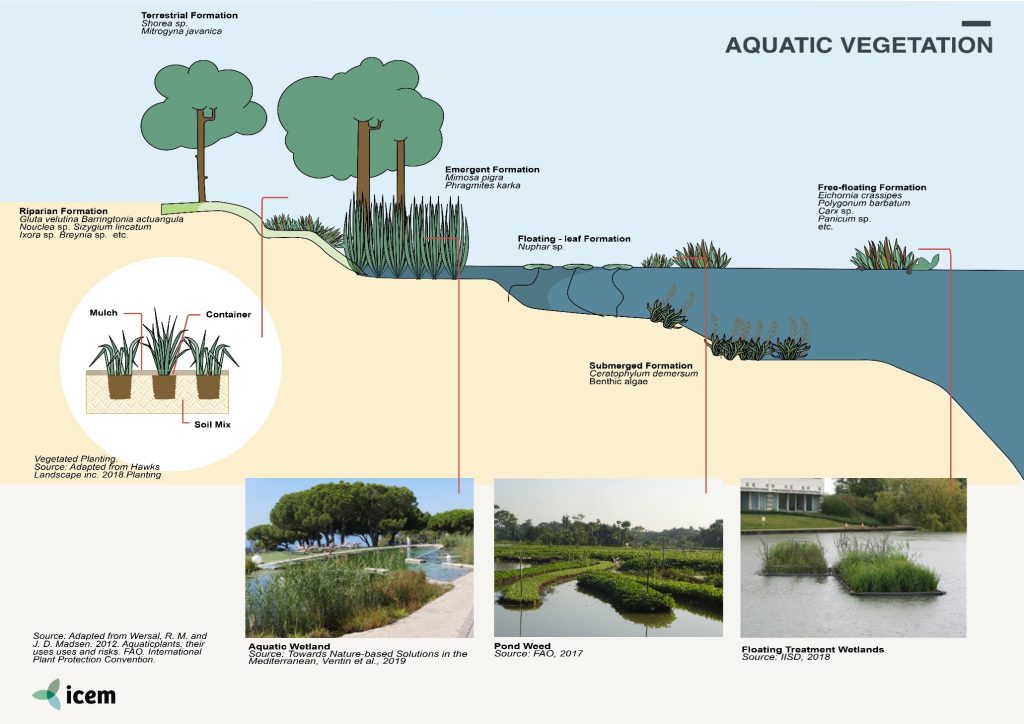| Suburban | River | Low-cost | Riverbank erosion | |
| DESCRIPTION | ||||
| Measures
|
This measure involves the planting of native aquatic plants (e.g., Eichhornia crassipes (water hyacinth), Ipomoea aquatica (swamp morning-glory) or Pistia stratiotes (water lettuce)) species that can grow along the edges of the river channel where they are often under water during the rainy season. The deep, robust root systems of these plants bind soils in the area where the majority of erosion is occurring, just below the water surface. This strengthens the river bed and bank toe and prevents soil from being washed away during floods while the emergent vegetation slows the flow velocity at the edge of the channel. Once established the plants will naturally filter the water thus improving water quality and they also provide many other ecological benefits beyond erosion prevention. | |||
| Location | Suitable for lakes, ponds and slow-moving waterways. Aquatic plants are typically installed at the water’s edge or on shelves in the littoral zone. | |||
| Design options and performance
|
Performance is enhanced by incorporating the plantings with other bioengineering measures which provide added protection particularly when young plants are established. These include:
● Stakes or poles: aquatic vegetation can be protected by a line of poles or stakes near the bank to allow them to become established. ● Geotextile fabric wrap: rooted plants are wrapped in natural geotextile fabric, placed in trenches, and staked down. The resulting root mat reinforces soil particles and extracts excess moisture through transpiration. ● Coir rolls: the rolls are placed and staked down near the edge of the stream or lake where they reduce wave energy and protect the aquatic vegetation planted behind ● Plant mats: a plant mat can instantly provide an area with herbaceous ground cover. This technique can be used on lakeshores and on quiet stretches of streams. The mats are 5 to 7.5 cm thick made of nonwoven coconut fiber held together with organic latex and secured with a high tensile strength net backing. Herbaceous plants, such as sedges, and/or emergent aquatic plants can be grown on a mat in a hydroponic setting, and then transported to the project site. |
|||
| Feasibility criteria
|
Should not be used in fast-flowing streams. Appropriate for wetland areas in urban lakes or waterways not subject to high flow velocities.
● Technical design: Should be planted at the margins of channels and the bank toe. Appropriate plant species, marginal or submerged should be selected for the planting positions. ● Materials: Aquatic vegetation can be protected by a line of poles or stakes near the bank to allow them to become established. |
|||
| Operation and maintenance | Annual maintenance is necessary and the planted areas should be inspected after long periods of low flows when the bank toe or lake edge may dry out, when weeds or invasive species invade and whenever water quality is affected (algae). | |||
| Cost and benefits | This is a low-cost measure. Planting aquatic plants on the banks of streams and ponds provides the following benefits:
● Wind and wave energy is dampened reducing erosive forces on the bank; ● Pollutants in runoff are filtered; ● Nutrients that grow algae are absorbed; ● Sediment is trapped; ● The vegetation provides cover and forage for fish and invertebrates and results in an improved ecosystem. |
|||
| Design solutions | Aquatic vegetation is an appropriate nature-based solution for ponds, wetlands and slow-flowing reaches of streams. Shallow water areas and lower slopes of the riparian edge should be planted as needed to protect the bank toe. Attention should be given to the following:
● Plants should be able to tolerate poor water quality for a short period and filter pollutants; ● Bank stabilization may be required, especially on bank-cut sides. Consider using live stakes for planting, coir rolls or another of the methods mentioned above; ● Plugs are preferred, particularly in areas where higher water velocities can be expected. |
|||
| Environmental performance | ● Offers relatively inexpensive and immediate protection from erosion;
● Grows in water and survives fluctuating water levels; ● Reduces toe erosion and creates an energy-dissipating area at the bank; ● Retains soil and transported sediment at the edge of the river or pond; ● Enhances conditions for natural colonization and establishment of vegetation from the surrounding plant community. |
|||
| Sources | ● Noble Research Institute, LLC, Ardmore, Oklahoma, https://www.noble.org
● Clemson University, SC, https://www.clemson.edu/ |
|||
Download PDF
Originally developed under the ADB ‘TA-9417 VIE: Secondary Green Cities Development Project – Output 2: Demonstrated sustainable and resilient development in Hue, Ha Giang and Vinh Yen’. Adapted for the UN-CTCN project ‘Climate risk assessment for subnational adaptation and establishment of a local climate information system for climate change adaptation (LISA) in Cambodia’.



